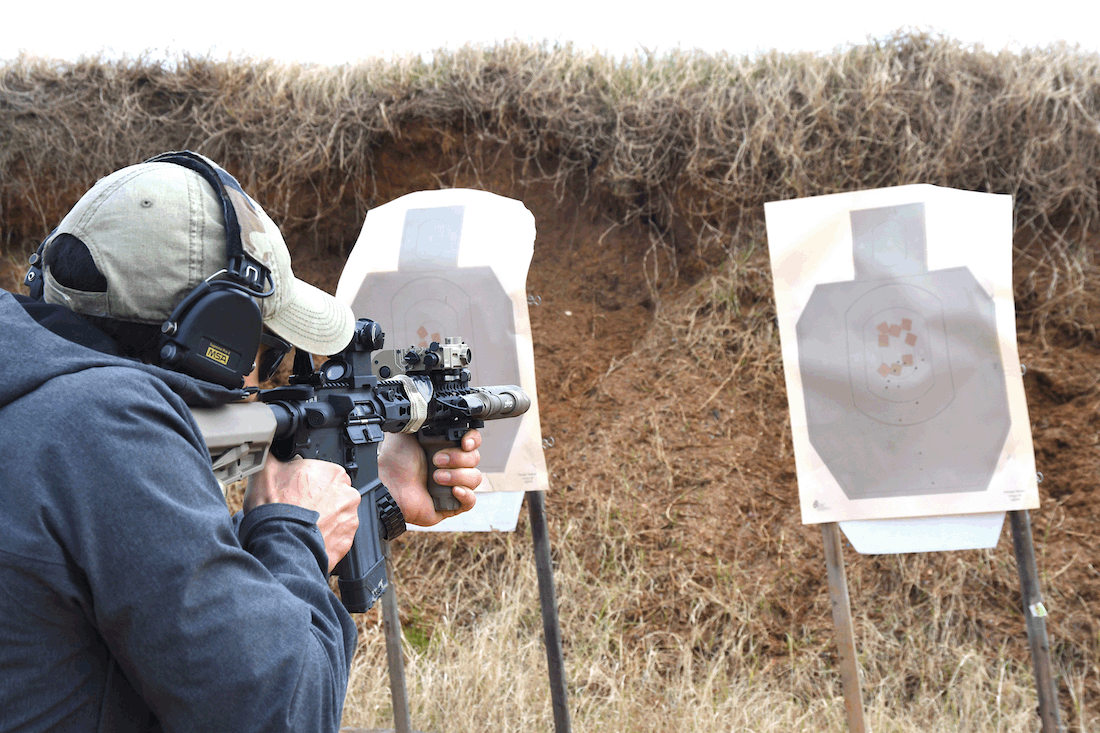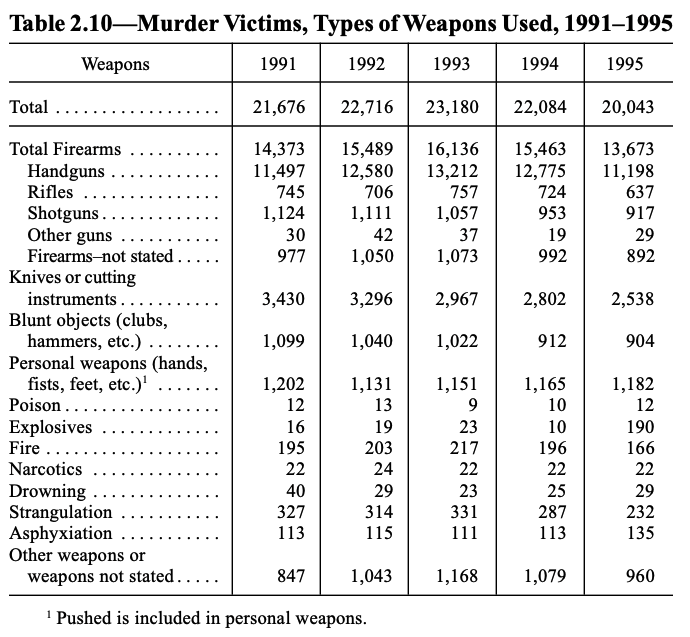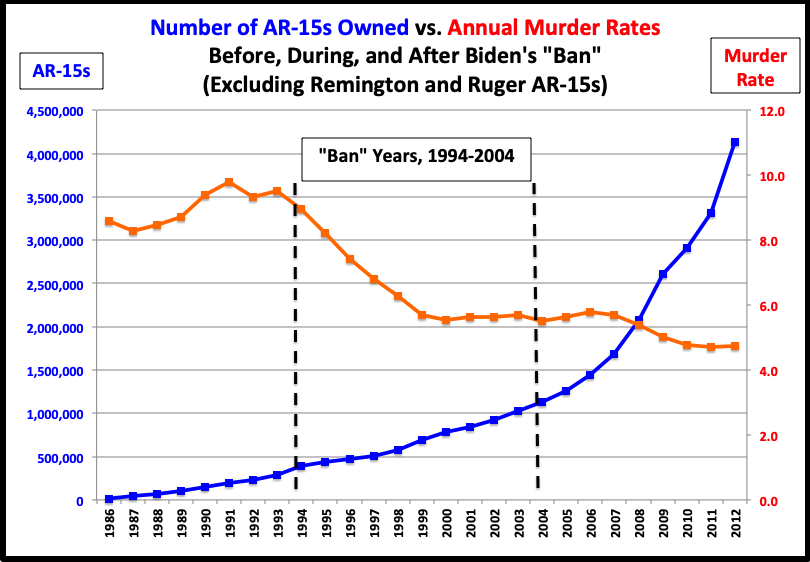Fact-Checking Biden’s “Assault Weapons” Claim
Along with his “three” college degrees, civil rights protest arrest, and other whoppers, Biden’s gun-ban claim is a lie.
On March 1, at the House Democratic Caucus Issues Conference, nominal president Joe Biden repeated his threat to “ban assault weapons” and claimed that murders committed with guns were reduced “when we did it last time.”1
By “last time,” Biden meant the federal so-called “assault weapon ban” of 1994-2004, sponsored by Dianne Feinstein (D-Calif.) in the Senate and Charles Schumer (D-N.Y.) in the House of Representatives as an amendment to then-Sen. Biden’s massive crime bill.
As the late, great comedienne Joan Rivers used to say, “can we talk?”
The Biden-Feinstein-Schumer “assault weapon ban” not only did not reduce murders, there is no way that it could have done so. One reason for that, is that only about three percent of murders committed with firearms (or about two percent of all murders) were ever committed with the rifles in question, and any criminal somehow unable to acquire one of the rifles could simply get a different gun or use some other weapon. (As shown in the following table published by the FBI, more murders were being committed with knives, more with bludgeons, and more with hands and feet, than with rifles of any type, let alone those that Democrats and their allies called “assault weapons,” assuming such rifles accounted for three percent of “firearms—not stated.”)
There’s another reason the “ban” could not have reduced murders. As the chart below shows, the murder rate (murders per 100,000 population) began decreasing nationally several years before the “ban” was imposed, and continued decreasing after the “ban” expired, as acquisitions of the guns soared. (Note that the chart does not include the numbers of AR-15s manufactured and sold by two of America’s largest firearm manufacturers, Remington and Ruger, because their AR-15 production cannot be distinguished from their production of other rifles in Annual Firearm Manufacturer and Export Reports published by the Bureau of Alcohol, Tobacco, Firearms and Explosives, or BATFE.)
Furthermore, notice that the chart above shows the number of AR-15s increasing while the “ban” was in effect. This is where the story gets interesting, so to speak.
For starters, the “ban” had zero effect on imported firearms
As with other topics in the debate over the right to keep and bear arms, to grasp this one requires that we step into the Wayback Machine. As French author Andre Gide once observed, “Everything that needs to be said has already been said. But since no one was listening, everything must be said again.” Or something like that.
In 1968, a Democrat Congress passed, and President “Landslide”2 Lyndon B. Johnson signed into law, the Omnibus Crime Control and Safe Streets Act, and the Gun Control Act, one provision of which (18 USC 925(d)(3)), permitted the Secretary of the Treasury to approve the importation of any firearm or ammunition that is “generally recognized as being particularly suitable for or readily adaptable to sporting purposes.” (Today, as amended, the provision requires the Attorney General to approve the importation of such firearms and ammunition.)3
Soon after the Gun Control Act took effect, the BATF (as the agency was then known), which has regulatory authority to interpret federal firearm laws, approved the importation of several rifles that Democrat politicians, their voters, civilian disarmament activists, and their mainstream media allies now refer to as “assault weapons.”
These included the semi-automatic-only Beretta BM59, SIG AMT, and CETME, which are versions of “selective-fire” rifles (meaning those that are capable of fully-automatic as well as semi-automatic fire) issued to military forces. (Selective-fire firearms are defined as “machineguns” under 26 USC Chapter 53 and prohibited from importation by 18 USC 925(d)(3), linked above.)
Over time, the BATF approved the importation of numerous other comparable semi-automatic-only rifles, such as AK-47s, AKMs, and AKSs from various countries; Israeli Galils; Finnish Valmets; German Heckler and Koch 91s, 93s, and 94s; Italian Beretta AR-70s; Belgian Fabrique Nationale FALs, CALs, and FNCs; and Austrian Steyr AUGs.
In 1985, Newsweek began the fake news media-induced panic over “assault weapons” with its “Machine Gun U.S.A.“ issue, which—in a single article—described imported and American-made semi-automatic rifles as “machine guns,” “automatic weapons,” “assault weapons,” “rapid-fire weapons,” “military guns,” “exotic military guns,” “military-style assault guns,” “sophisticated paramilitary guns,” “paramilitary ‘grease guns,’” “modern combat weapons,” “maxi-violence weaponry,” “exotic weapons,” and “the mainstay of commandos,” and which just as absurdly claimed that the rifles could be fired between 600 and 1,100 shots per minute.4
In 1989, at the order of Pres. G. H. W. Bush (who, to his credit, opposed a ban on the manufacture of comparable rifles in the U.S.), the BATF, in its Report and Recommendation on the Importability of Certain Semiautomatic Rifles, reversed its interpretation of 18 USC 925 (d)(3) to prohibit the importation of 43 makes and models of foreign-made rifles.
To deliver what Bush wanted, the BATF had to deal with why it had allowed the importation of the rifles in question from 1968 until 1989, and with the two separate conditions under which a firearm can be eligible for importation under 18 USC 925(d)(3): if it is “generally recognized as particularly suitable for . . . sporting purposes” or “generally recognized as . . . readily adaptable to sporting purposes.”
The BATF dealt with its 1968-1989 interpretation of the law by saying that, upon further review, it considered that interpretation “superficial and unpersuasive.” It dealt with “readily adaptable to sporting purposes” by ignoring it.
How it dealt with “particularly suitable for . . . sporting purposes” is more complicated. On some points it was correct and on others it made stuff up.
The BATF was correct in saying that the rifles in question, like their selective-fire ancestors, can use detachable magazines holding generally 20 or 30 rounds of ammunition, depending on the caliber, and may have an adjustable-length or folding stock, a “pistol grip,” a bayonet mount, a bipod, “night sights,” a flash suppressor, or a special-purpose flash suppressor that can function as a grenade launcher (never typically installed on the rifles for commercial sale, given that grenades are restricted under 26 USC Chapter 53, linked above).
The BATF was also correct that, generally, the rifles in question are the semi-automatic-only versions of selective-fire rifles, and that they are designed to use centerfire ammunition cartridges “having a length of 2.25 inches or less.”
However, the BATF was incorrect in concluding that these factors, in and of themselves, failed the rifles under either the “particularly suitable for” or, especially, the “readily adaptable to” sporting purposes tests. As examples, the most expensive rifles used for the most precision-oriented target shooting competitions have stocks that are adjustable for length, many of them are typically equipped with bipods, and many calibers of ammunition used for sporting purposes (the vast majority of which have never been used in any rifle used by any military force on Earth) use cartridges shorter than 2.25 inches, an example being .30-30 Winchester, one of the most popular deer hunting calibers in U.S. history.
[It was common for military bolt-action rifles (Springfields, Mausers, Lee-Enfields, etc.) to be “sporterized” into hunting rifles, by replacing their stocks and removing various hardware. Something similar could have been done with the subject rifles in 1989.]
Furthermore, while the BATF recognized that “organized marksmanship competition” constituted a “sporting purpose” for purposes of 18 USC 925(d)(3), it ignored the most popular rifle marksmanship competitions at the time—(1) the Service Rifle category of NRA High Power Rifle and (2) Service Rifle, under the auspices of the then-Director of Civilian Marksmanship (now the Civilian Marksmanship Program), established by Congress to advance military rifle training among the general public. These competitions, which culminate annually at the National Matches (also authorized by Congress) required (and still require) the use of genuine military service rifles or their semi-automatic-only variants, military ammunition magazines and, prior to 1989, required flash suppressors and bayonet mounts on rifles normally equipped with them. (The term “service rifle” refers to a rifle that is normally issued in military service.)
In any event, because the rifles’ importation was banned five years before Biden’s 1994-2004 “ban” was imposed, and because Biden’s “ban” didn’t prohibit the possession, sale, or purchase of rifles that had already been imported, Biden’s “ban” had zero effect on imported rifles.
Biden’s ban had almost zero effect on U.S.-made “assault weapons”
Even more undercutting of Biden’s claim than its zero effect on imported “assault weapons,” it had little, if any, effect on those made in the United States. That is because of two factors: First, the “ban” prohibited only the manufacture of “assault weapons,” not their sale and purchase, so manufacturers increased production before the “ban” took effect, to have inventory on-hand to sell after it took effect.
Second, the “ban” prohibited the manufacture of the guns in question only in certain configurations. For example, AR-15s were prohibited from manufacture with an adjustable-length stock, flash suppressor, or bayonet mount, but could be manufactured and sold without those features. Therefore, during the 10 years the “ban” was in effect (Sept. 13, 1994 to the same date in 2004), more than 730,000 AR-15s like the one pictured below were manufactured and sold/purchased.
One final note. When Biden and other Democrats talk about “reinstating” the 1994-2004 “ban,” they are lying about that too. As I explained here, the ban they support today is much more severe than the one of yesteryear.
Notes:
1. Midway through the Obama administration, progressives elevated “guns” to one of their core issues for motivating their voter base.
2. Democrats have been stealing elections for a long time. Johnson’s “Landslide” nickname is due to his having “won” the 1948 Democrat Party U.S. Senate primary in Texas after just enough “votes” were “discovered” in a single precinct in a south Texas county, cast by “voters” who had signed in at the polling place in alphabetical order, in the same handwriting, with the same pen. Some of the “voters” resided in a local cemetery, others swore they had not voted, and others said that in that neck of the woods, run by Democrat party boss George Parr (a convicted felon pardoned by Democrat President Harry S. Truman), you lived longer if you kept your mouth shut. In signing the Gun Control Act into law, Johnson complained that it did not require registration of all guns and licensing of all gun owners.
3. In 1968, the provision was supported by the U.S. firearm industry for protectionist reasons: banning the importation of guns forced Americans to buy more American-made guns. In light of the Supreme Court’s ruling in District of Columbia v. Heller (2008) that the Second Amendment protects a fundamental, individually-held right to keep and bear arms for defensive purposes, the “sporting purposes” limitation is now arguably unconstitutional.
4. Because we express time in minutes and seconds, and a machine gun, such as an M60, M249, or M240, can fire for longer than a second, the rate of fire for such guns is typically expressed in terms of rounds-per-minute. However, that is only a theoretical rate of fire, because no such machine gun is fired continuously for a minute, because (1) it doesn’t hold enough ammunition to fire continuously for that length of time and (2) continuous firing for one minute would overheat the barrel, damaging the gun. Because the firing rate of machine guns is expressed in rounds-per-minute, the same manner of expressing the theoretical rate of fire is used for selective-fire rifles, such as the M16, when set to fire fully-automatically. However, while the M16’s theoretical firing rate is over 600 rounds per minute, its standard magazine holds only 30 rounds. Furthermore, to avoid overheating the barrel and damaging the rifle, its sustained rate of fire is 12-15 rounds per minute. Because so-called “assault weapons” fire semi-automatically, not fully-automatically, their maximum practical rate of fire is roughly half that of an M16.
© Mark Overstreet 2023






